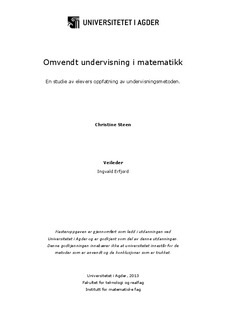| dc.description.abstract | Many teachers want to try out different teaching methods to find the one that makes students learn best. In today's society we surround ourselves with technology most of the day and there are several teaching methods that make use of technological tools in different ways. The “flipped classroom” is one of these and this is a method that has become more and more popular around the world and now also in Norway. In short, this is a method where students get theoretical review outside the classroom by using instructional videos, while solving problems and other learning activities are carried out at school with the teacher present. This is still a relatively new form of teaching with little research around it. I examine in this study, students' perception of this type of teaching. Through a brief survey, semi-structured interviews with eight students and observation of classroom and video instruction, I seek to answer the following research question:
"What are students’ beliefs about the flipped classroom model in mathematics?"
In order to answer this, I also formulated the following three questions:
• According to the students, what are the advantages and disadvantages with the flipped classroom?
• What do students think about the flipped classroom compared to traditional teaching methods in mathematics?
• What do students think about their own role and the teacher's role in the flipped classroom?
The methods for analyzing students' responses are largely qualitative, but I 've also included a quantitative overview of the class as a whole based on the survey. The answers the students gave during the interviews are analyzed and categorized, and on this basis I believe that I have gained insight into their beliefs’ about the flipped classroom.
The finding that is most prominent in my eyes is that students' performance in mathematics has improved from high school and at the same time they now spend less time on the subject.
Other findings I mention are that students seem to like a more predictable homework situation and they are also very positive to the instructional videos. Benefits mentioned with the videos are that students can see them at the pace they want, they can take breaks whenever they want and they can watch them as many times as they want. Students feel that they get more help from the teacher in the flipped classroom model and that the method leads to better learning.
One last finding is the students' satisfaction with the use of technology in teaching, because they believe this is in line with developments in society.
The study´s findings suggest that students have developed a positive belief of the flipped classroom model.
Although the sample in this study was relatively small and limited to one class, it is reasonable to assume that my findings will also apply in other circumstances. The flipped classroom model has a clear structure by the students´ use of instructional videos as a start and then work on the subject matter at school. This means that my findings should be relevant to other teachers and student groups, even if the teaching might have other differences. | nb_NO |
